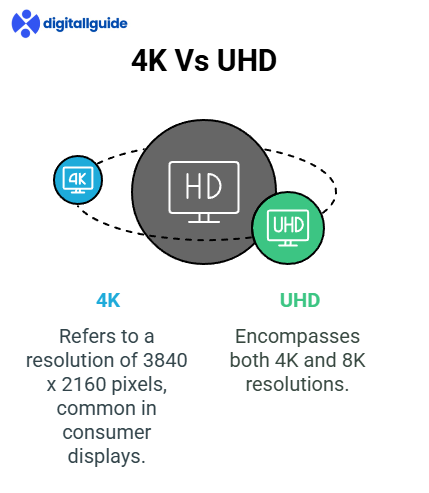4K vs UHD:
Let’s face it: shopping for a new TV or monitor is confusing. You’ll see terms like 4K, UHD, 2160p, and Ultra HD thrown around like confetti. But here’s the kicker—they’re NOT the same! Picking the wrong one could cost you money or leave you stuck with a screen that doesn’t meet your needs. Let’s cut through the real differences between 4K vs UHD.
In This Article
What is 4K? (Spoiler: It’s Not Just “Really Good Quality”)
The Nuts and Bolts of 4K Resolution
4K is a cinematic resolution standard set by the Digital Cinema Initiatives (DCI). Here’s the technical bit:
- Resolution: 4096 x 2160 pixels.
- Aspect Ratio: 1.9:1 (wider than most TVs).
- Where You’ll See It: Movie theaters, professional cameras, high-end video editing.
In simple terms? 4K is the gold standard for filmmakers. It’s designed to fill massive theater screens without losing detail.

What is UHD? (The “4K” Your TV Brand Won’t Stop Talking About)
UHD Demystified
Ultra High Definition (UHD) is the resolution you’ll find in 99% of “4K” TVs and monitors. Here’s why:
- Resolution: 3840 x 2160 pixels.
- Aspect Ratio: 16:9 (standard for TVs and YouTube).
- Where You’ll See It: Consumer TVs, streaming platforms like Netflix, gaming consoles.
UHD is slightly lower in pixel count than true 4K, but it’s tailored for home use. Brands often call it “4K UHD” because it sounds cooler.

4K vs UHD: The Showdown (Finally, a Clear Comparison!)
Let’s settle this once and for all with a side-by-side table:
| Feature | 4K | UHD |
|---|---|---|
| Resolution | 4096 x 2160 pixels | 3840 x 2160 pixels |
| Aspect Ratio | 1.9:1 (Wider) | 16:9 (Standard) |
| Common Use | Movies, filmmaking | TVs, streaming, gaming |
| Pixel Count | ~8.8 million | ~8.3 million |
| Marketing Terms | Rarely used for TVs | Called “4K” by brands |
Key Takeaway: 4K is for pros; UHD is for your living room.

Why 4K Might Be Overkill for You
- Pros: Future-proof for filmmakers, unmatched detail.
- Cons: Limited content, expensive gear, not optimized for TVs.
Why UHD is the People’s Champion
- Pros: Perfect for Netflix and gaming, widely available, affordable.
- Cons: Not true 4K, slightly fewer pixels.
How to Choose Between 4K Vs UHD (No Tech Degree Required!)
Ask yourself:
- Are you a casual viewer? → UHD is your match.
- Do you edit videos or watch Blu-rays? → Lean toward 4K.
- Gaming? → Most consoles (PS5, Xbox) use UHD.
Pro Tip: Most “4K” TVs are actually UHD. Check specs for 3840 x 2160 pixels to confirm.
The Future of Resolutions: Is 8K Going to Replace Both?
Short answer: Not yet.
- 8K TVs (7680 x 4320 pixels) are here, but there’s barely any 8K content.
- 4K/UHD will dominate for the next 5–10 years.
Save your cash—stick with UHD unless you’re a tech early adopter.
FAQs About 4K vs UHD
Q1: Is UHD the same as 4K?
A: Nope! UHD has fewer pixels (3840×2160 vs 4096×2160).
Q2: Which is better for gaming: 4K or UHD?
A: Most games use UHD. Unless you’re a pro designer, UHD works great.
Q3: Does Netflix use 4K or UHD?
A: Netflix streams in UHD but calls it “4K” for simplicity.
Q4: Can the human eye even see the difference?
A: On screens smaller than 55 inches, it’s hard to notice.
Conclusion: 4K vs UHD
The difference between 4K and UHD isn’t just technical nitpicking—it’s about knowing what you’re actually buying.
If you’re a movie buff craving theater-quality detail or a pro filmmaker, 4K is your holy grail. But for 99% of us? UHD is the everyday hero. It’s cheaper, widely supported, and perfect for binge-watching Stranger Things or dominating Fortnite.
Remember:
- Most “4K” TVs are UHD—check for 3840 x 2160 pixels.
- Don’t stress about pixel counts. On smaller screens, the difference is barely noticeable.
- 8K is still a sci-fi dream. Stick with UHD and save your cash.
At the end of the day, brands love to muddy the waters with fancy terms. But now? You’ve got the cheat code. Choose UHD for your living room, leave 4K to the pros, and laugh at the marketing myths.
Final Verdict 4K vs UHD:
Here’s the deal:
- Choose UHD for everyday TV, gaming, and streaming.
- Choose 4K only if you’re editing movies or want theater-level quality.
Now you know the real difference between 4K and UHD!


This Post Has One Comment
Pingback: 5G - The Fifth Generation of Mobile Technologies - Digitallguide